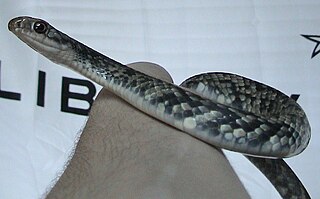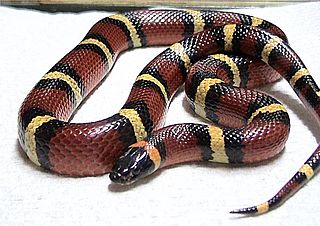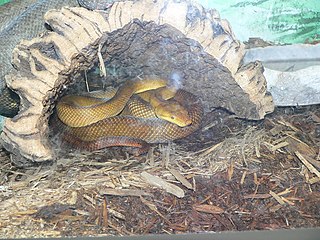
Platyceps gracilis, commonly known as the graceful racer or slender racer, is a species of snake endemic to West India.

Hemorrhois ravergieri, commonly called the spotted whip snake, is a species of aglyphous (non-venomous) ophidian snake in the family Colubridae. It is endemic to Western, Central and South-Central Asia, from Turkey in the west to Kazakhstan and western Mongolia in the east.

Masticophis flagellum is a species of nonvenomous colubrid snake, commonly referred to as the coachwhip or the whip snake, which is endemic to the United States and Mexico. Six subspecies are recognized, including the nominotypical subspecies.

Masticophis is a genus of colubrid snakes, commonly referred to as whip snakes or coachwhips, which are endemic to the Americas. They are characterized by having a long, thin body and are not dangerous to humans.

The eastern racer, or North American racer, is a species of nonvenomous snake in the family Colubridae. The species is endemic to North America and Central America. Eleven subspecies, including the nominotypical subspecies, are recognized, which as a group are commonly referred to as the eastern racers. The species is monotypic in the genus Coluber.

Lampropeltis annulata, commonly known as the Mexican or Tamaulipan milksnake, is a non-venomous species of milksnake. It is native to northwestern Mexico and some adjacent Mexico–United States border regions.

The horseshoe whip snake is a species of snake in the family Colubridae. The species is native to southwestern Europe and northern Africa.

Candoia bibroni—commonly known as Bibron's bevel-nosed boa, Bibron's keel-scaled boa, the Pacific tree boa or the Fiji boa—is a species of boa, a group of non-venomous, constricting snakes, endemic to the southern Pacific Ocean island chains of Melanesia and Polynesia. Two subspecies are recognized, including the nominate subspecies, described here. Candoia bibroni is one of the most isolated and far-removed species of boid snakes on earth, as the majority of boa species are found in the Americas and the Caribbean, or, in the case of the terrestrial sand boas, in Africa and Eurasia.

The yellow-faced whip snake is a species of venomous snake in the family Elapidae, a family containing many dangerous snakes. D. psammophis is endemic to Australia, found throughout the continent in a variety of habitats from coastal fringes to interior arid scrubland.

Platyceps najadum, also known commonly as Dahl's whip snake or the slender whip snake, is a species of non-venomous snake in the family Colubridae. The species is native to Eurasia. Four subspecies are recognized as being valid.

Hemorrhois nummifer, also known as the coin-marked snake, Asian racer, and leaden-colored racer, is a species of snake belonging to the family Colubridae. It is found in southeastern Europe, Western and Central Asia, and northeast Africa.

Wallaceophis is a genus of snake in the family Colubridae. It was first described in 2016. The sole species is Wallaceophis gujaratensis which is found in the Indian state of Gujarat. Wallaceophis gujaratenisis is presently known from just seven localities of Gujarat and virtually nothing is known about its biology. Common names Wallace's striped snake and Wallace's racer has been suggested for it.

Anniella stebbinsi, the Southern California or San Diegan legless lizard, is a small, slender lizard, and, as the name suggests, is legless. Not much is known about the lizard as a unique species, with most observations conducted while it was not recognised as separate from Anniella pulchra, the Californian legless lizard.













